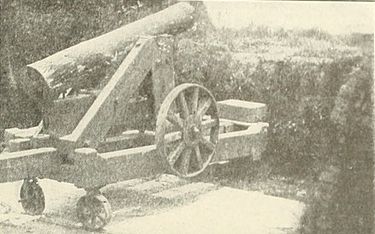 I recently gave an hour-long presentation on the Civil War in New Mexico to a group of 5th graders. This class will be getting a class set of Where Duty Calls, the first in a trilogy of middle grade novels set in New Mexico during the Civil War. They are studying the Civil War in their class, and they already knew a lot about the conflict. Luckily for me, I still knew a few things that they didn’t. One of the things they’d never heard about was the use of Quaker cannons.  Quaker Cannon placed behind German lines, WWI. By National Library of Scotland - https://www.flickr.com/photos/nlscotland/4687953503/, No restrictions, https://commons.wikimedia.org/w/index.php?curid=53213095 Quaker Cannon placed behind German lines, WWI. By National Library of Scotland - https://www.flickr.com/photos/nlscotland/4687953503/, No restrictions, https://commons.wikimedia.org/w/index.php?curid=53213095Quaker cannons are wooden logs that have been rigged up to resemble cannons. Often, they are painted black. Sometimes they are mounted on wheels or placed in gun carriages. The object of a Quaker gun is to deceive the enemy forces into believing that the place where they were used was much more heavily fortified. The name comes from the nickname for the Religious Society of Friends, who were pacifists. Because of their religious opposition to war and violence, Quakers would not fire on the enemy, and neither would a log painted to masquerade as a cannon.  William Washington William Washington Quaker cannons are not exclusive to the Civil War, and they weren’t used only in New Mexico. Many historians believe that that they were first used during the American Revolution by American Colonel William Washington, a second cousin of our first president. On December 4, 1780, after nearly a year of brutal backcountry fighting, Colonel Washington’s light dragoons managed to surround the Loyalist Colonel Rowland Rugeley’s force of about 125 men. Rugeley's men barricaded themselves in their Colonel’s house and barn, near Camden, South Carolina. To flush them out, Washington had a pine log made up to resemble a cannon. He aimed his decoy at Rugeley’s house and barn and threatened to open fire if they did not immediately surrender. Rugeley surrendered his entire force without a single shot being fired. The "Quaker gun trick" worked.  Confederate General Joseph E. Johnston Confederate General Joseph E. JohnstonBoth the Union and the Confederacy used Quaker cannons during the Civil War. During the siege of Port Hudson, in Louisiana, Confederates painted black rings onto the ends of logs and mounted them facing the river so that the Union would believe they were much better armed than they were. It worked. Admiral Farragut's two vessels passed Port Hudson by, and the Union never attempted a river-side attack. In March 1862, Confederate General Joseph E. Johnston placed Quaker guns in his field works around Centreville, Virginia so that Union troops would believe that the works were still occupied as his men withdrew to the Rappahannock.  E. R. S. Canby (as a Major) E. R. S. Canby (as a Major)In New Mexico, Quaker cannons were used by Colonel E. R. S. Canby to bolster the defenses of Fort Craig. Although his forces outnumbered those of the invading Confederate army led by Brigadier General Henry H. Sibley, Canby, who commanded all forces in the New Mexico Territory, was a cautious man. By the time the Confederates arrived, the fort bristled with cannons, some Quaker and some actual. Sibley's army was traveling light; he had convinced Confederate President Jefferson Davis that New Mexicans would support his army, and that the forts would easily fall, offering up their stores of food and ammunition, Fort Craig was, then, to be both a Confederate conquest, but a handy resupply depot for the southern troops. However, after a standoff of one day,. Sibley decided that the fort was too heavily fortified. He directed what he called a "roundance on Yankeedom," going around the fort and forgoing its supplies. Once again, the Quaker cannons had done their job without firing a shot.  Jennifer Bohnhoff is a retired New Mexico history and language arts teacher who now writes in her home high up in the mountains of central New Mexico. Where Duty Calls will be published June 14. It can be preordered in both paperback or ebook. Contact Geoff at Artemesia Publishing if you’d like to purchase a class set of Where Duty Calls. If you’d like to purchase class sets of any of Ms. Bohnhoff’s other books, contact her directly. Special rates are available for all bulk orders. Ms. Bohnhoff would love to present to classes, civic or book groups, social clubs, or others who are interested in the topics in her books. For a list of other books about the Civil War that are suitable for middle grade readers, click here. Mrs. Bohnhoff is an affiliate of Bookshop.org and receives a commission when people buy books by clicking through links in her blog or on her shop at https://bookshop.org/shop/jenniferbohnhoff. A matching commission goes to independent booksellers. However, she encourages people to also see if these books are available at their local library. |






No comments:
Post a Comment